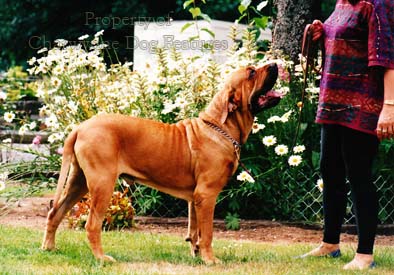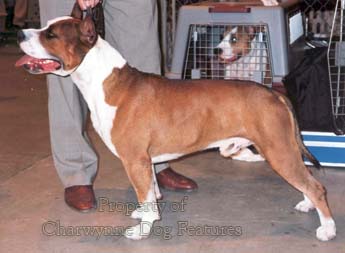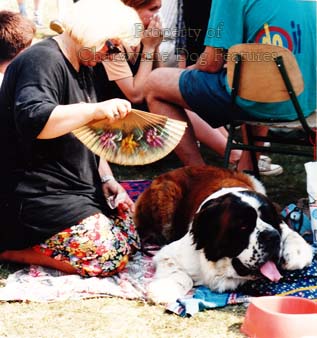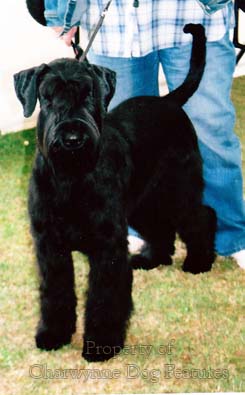398 World Dog Show-2003 Dortmund
THE UNWORLDLY WORLD DOG SHOW
by David Hancock
 The so-called World Dog Shows are becoming annual fixtures in the show calendar for many British exhibitors, especially since quarantine regulations became more reasonable. I describe them as 'so-called' because it seems to me to be an inaccurate title; most countries of the world are not represented and the entry is not that of the world's best dogs. It could in time become the annual international show for the wealthiest exhibitors; the next show is in Rio de Janeiro, the one after that in Buenos Aires. However overcritical it may seem, it is only honest to say that I have never seen so many handsome but unsound dogs in one place as at the 2003 Dortmund show. We all like a handsome dog but dogs are at our whim and deserve greater respect than this. Anatomical unsoundness affects their well-being and, amidst all the frenzied acclaim of new champions, we need to ponder the inflictions which ensue when humans are striving to achieve success; it must never be at the expense of the dogs.
The so-called World Dog Shows are becoming annual fixtures in the show calendar for many British exhibitors, especially since quarantine regulations became more reasonable. I describe them as 'so-called' because it seems to me to be an inaccurate title; most countries of the world are not represented and the entry is not that of the world's best dogs. It could in time become the annual international show for the wealthiest exhibitors; the next show is in Rio de Janeiro, the one after that in Buenos Aires. However overcritical it may seem, it is only honest to say that I have never seen so many handsome but unsound dogs in one place as at the 2003 Dortmund show. We all like a handsome dog but dogs are at our whim and deserve greater respect than this. Anatomical unsoundness affects their well-being and, amidst all the frenzied acclaim of new champions, we need to ponder the inflictions which ensue when humans are striving to achieve success; it must never be at the expense of the dogs.
If you want to see breeds of dog little known in this country, then this show has some appeal. Impressive breeds like the Tosa, the Fila Brasileiro, the Dogo Argentino and the American Staffordshire Terrier are not welcome here, because of our wholly misguided Dangerous Dogs Act. But they draw my admiration at each world show I attend because of their equable temperaments. They are always amongst the best behaved breeds on show, with the Amstaff usually appearing to be amongst the best for physical soundness. Emergent breeds like the Eurasier, the Kromfohrlander and the Czech and Saarloos Wolfdogs, and breeds being restored, like the Aidi, the Broholmer, the Rafeiro do Alentejo and the Smoushond are always of interest.
This was the fifth World Dog Show to be held in Dortmund; the first one in 1956 drew three and a half thousand entries, this one drew over 18,000, over 7,000 from outside Germany. There were around 900 dogs in the crossbreeds competition, but I really cannot see the point of such an entry at this show. These shows are either about the display of pure-bred breeding material or they are nothing. With exhibitors from 55 countries and 169 judges from 35 countries this show had a wide appeal. It you want to know a Puli from a Pumi or your Entlebucher from your Appenzeller, this is the show for you. It can also provide a variety of surprises! Until attending this show, I had never seen a lady with the head of a black Schnauzer tattooed on her shoulder, or a formidable-looking Bullmastiff bitch bearing the name 'Grace Kelly' or observed such brazen double-handling as at one Rottweiler class. For me the latter is the height of bad behaviour and has to be eradicated.
Once again I was dismayed to see our native breeds looking so untypical. It was difficult to tell the Golden Retrievers from the blond Hovawarts. There were Cairn Terriers with round eyes and no stop. There were Shetland Sheepdogs like 'walking coats', with snipey muzzles and eyes far too small. There were Airedales there with fluffy coats, round eyes and Fox Terrier fronts. The halo-headed Westies I didn't like, the shelly Beardies were not impressive, the Manchester Terriers looked more like black and tan Whippets. The entry of dogs from our breeds was high; the top two in the show were the Golden and the Labrador Retrievers, with 13 of the numerically top 30 breeds entered originating here. Are we exporting inferior stock or can the continental breeders not appreciate true breed type? I have every respect for foreign breeders, after all at Crufts in the Working Group this year, foreign dogs won three out of the four prizes on offer.
There were many really good dogs of course amongst such a substantial entry. I liked the look of the Sarplaninac, the Entlebucher Sennenhunde, the Hovawarts, the Schnauzers, the Cane Corso, the Do Khyi (our Tibetan Mastiff), the Landseer Newfoundlands and the Great Danes. I was depressed to see so many Pyrenean Mountain Dogs with flat feet, so many Dogues de Bordeaux with poor movement, so much variety in head-shape amongst the Bullmastiff entry (when is this breed going to decide what the breed's head should look like?) and so many low-quality exhibits being rewarded. Such a nominally prestigeous show should not become degraded by unworthy winners. These shows should be founded on the pursuit of excellence not the recognition of mediocrity. Winning dogs get bred from; most of the entry I viewed was hardly world class.
A show bearing the title 'World Show' surely has to carry the torch for dogs and their care. It was not good for the best interests of dogs for this show to be held in hot weather in a stifling venue. On the Saturday of the show I don't think I have ever seen so many discomforted dogs in one place; 5 died in vehicles parked inside the grounds, far too many looked distressed. This is not the image of dog-care any dog show would wish to project; this is not world-class animal welfare. Exhibition venues, and I include the NEC, are NOT the place for dogs' comfort. At every major dog show the public are viewing the sport of showing dogs; far too often the sceptics are made more sceptical, the anti-show lobby given more ammunition. In the smart city-centre hotel I stayed in, there were eleven cases of carpet-staining by guests' dogs in the fifty feet between my room and the lift. Is it surprising that there is an anti-dog lobby?
In Dortmund, according to the local press, 54 dogs had to be released from parked cars by the police; 11 cars had to be broken into when their owners could not be located; 2 puppies were taken from one car by animal welfare workers. This is a disgrace to the name of dog-showing; much of the blame must be put on those who chose the venue, the time of year and the facilities, as well as the despicable dog-owners concerned. The rings in some areas of this show were surrounded by distressed dogs; that is not acceptable. But unless more thought is given to the welfare of dogs and less to the splendour of the setting, it will happen again and again. The show organisers may well boast of their 18,000 entry; the death of 5 dogs in the car park is the statistic I will remember. Agricultural show grounds are the place for dog shows not city-centre exhibition halls if the needs of dogs are to be placed first.
Of course, dogs can die in unattended cars on hot days at agricultural show grounds. But then it is solely the fault of their owners, who should be banned for life from showing dogs at shows held under a KC licence. Venues are the responsibility of show officials and when such a choice leads to dogs suffering, they should be made to suffer too by losing their appointments and the removal of the KC licence from that show. The blind pursuit of rosettes, the wish to boast of a high entry and the kudos of being associated with a top show, all have to be very much secondary to the needs of the dogs entered. Our own KC should insist on an animal welfare audit for every show venue; by holding their own annual show at the NEC, they are setting a poor example. How on earth can 'the improvement of dogs', the KC's mandate, be achieved when a venue is chosen solely because it suits humans?
A 'World Dog Show' should surely have world class standards in every facet of its show. To see the heavier-coated breeds panting hard in stifling conditions does no credit at all to those who would be the first to claim a love of dogs in their motivation. I saw St Bernards, Newfoundlands, Owtcharkas, Estrelas, Leonbergers and Bernese Mountain Dogs at this show in distress. Whilst this was not pleasant to witness, the indifference of their owners in a number of cases was spine-chilling; they simply didn't care. If they represent to the public an image of show dog people then the days of dog showing may be numbered. That may sound dramatic and overstated but if a livestock market had been held like this, the increasingly potent animal welfare groups would have sought closure.
An exhibitor of a heavy-coated breed could legitimately claim that if the venue is stiflingly hot then their breed will not show well, and certainly will not move confidently, and therefore the contest is unfair, especially at Group level, when competing against, say, a hairless dog. It was interesting to watch the Swiss breeds in the ring; the smooth-coated Appenzellers and Entlebuchers were relaxed and at ease, the heavier-coated Bernese were sluggish and ill at ease, relatively. The venue should surely support the judge not make his job more difficult. I didn't envy the judge from England who was judging Mastiffs, not just because of the airlessness of the ring, but because his entry seemed to have been bred for beef, rather than any accepted canine function. This was in stark contrast to the mastiff breed from Denmark, the Broholmer, which was substantial but not so as to threaten the well-being of the dogs. In previous centuries no Mastiff would have been prized for its bulk, why now?
I was impressed by some of the Leonbergers and most of the Great Swiss Mountain Dogs, a strapping handsome breed with no exaggerations and a manageable coat. I was less impressed by the Spanish Mastiffs, a flock guarding breed rather than a classic mastiff breed. Their mobility was severely hampered by excessive bone; they were quite unlike the huge but more active spike-collared flock guardians I once saw in northern Spain, actually working for their keep. The Sarplaninac, the big Yugoslavian herder, looked a fine breed, but I find it very difficult to distinguish this breed from the Kraski Ovcar or Karst Shepherd Dog from Slovenia. Both were entered and I really needed an expert on each breed to enlighten me on their differences. Both resembled a wolf-grey Estrela Mountain Dog. The Tibetan Mastiff entry was impressive, with many looking far bigger than the ones I see here, and with a wider range of coat colours. The Russian Owtcharkas were imposing dogs and not to be trifled with. 
It is strange to see the customarily docked breeds with fuller tails, some undocked but naturally abbreviated. Rottweilers, Schnauzers, Black Russian Terriers and Boxers featured undocked tails of varying length. The presence of the tail in such breeds does affect the way the eye sees them and appears to influence not just the tail carriage but the structure of the hindhand too. It will take some time, I believe, in a number of breeds, to restore the symmetry of the dog and stabilise the correct breed type for tail carriage; docking does alter more than just the tail, the croup looks unusual in some formerly docked breeds, when the tail is fully grown but stunted. This must affect the balance of the dog concerned. Breed type is involved here.
Annual national and international dog shows, and World Dog Shows in particular, should display not only the best dogs, but the best dog-care. I would rather see an entry of 10,000 really top quality dogs at such a show than 20,000 dogs with some poor specimens amongst them. It should be hard, not easy, to qualify for entry at such a show. The appointed judges too should merit our respect and their appointment be richly deserved. A knowledgeable objective observer at the ringside should never have cause to shake his head in disbelief or have to stop himself from bursting out laughing--from exasperation. A smaller better entry would support the pursuit of excellence aimed for at such shows. Raising the standard of judges would ensure that the better dog wins; at one world show I witnessed one exhibit gaining first place despite featuring cow-hocks, loose shoulders and a stuffy neck; that is not impressive.
The public too when visiting a top show should see dog-care at its very best. When dogs die in cars, when the route to the show from the carpark is heavily fouled by dog-excrement (as at Crufts) and when the show contains hundreds of hard-panting exhibits because the venue is not dog-friendly, then the whole sport of dog-showing is degraded and undermined. This aspect now needs urgent attention. If five hounds died in one day in the hunting field, the animal welfare lobbyists would raise their banners and demand action. They would have my support. But when they look the other way, ignoring dog show cruelty because it doesn't form part of their wider hidden agenda, I despair. And when dog show organisers select venues to suit human needs and ignore the well-being of dogs, they deserve to be replaced by more compassionate genuinely dog-loving appointees. Every licence issued by the KC for a show under their rules should embrace a dog-welfare audit setting out why the venue is supported. We all surely desire world-class canine comfort at shows, whatever their standing or status.